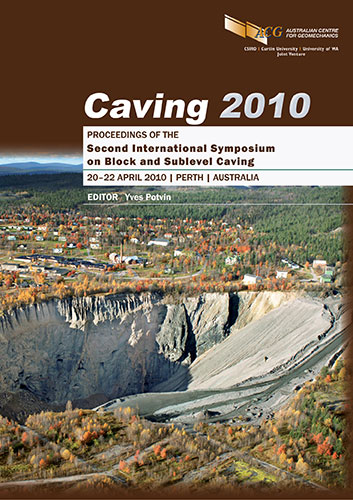Block cave optimisation — a value driven approach

|
Authors: Stewart, CA; Allman, A; Hall, BE |
DOI https://doi.org/10.36487/ACG_rep/1002_13_Stewart
Cite As:
Stewart, CA, Allman, A & Hall, BE 2010, 'Block cave optimisation — a value driven approach', in Y Potvin (ed.), Caving 2010: Proceedings of the Second International Symposium on Block and Sublevel Caving, Australian Centre for Geomechanics, Perth, pp. 219-230, https://doi.org/10.36487/ACG_rep/1002_13_Stewart
Abstract:
Optimising the footprint, production rate and block height of a block caving operation is a trade-off between technical and value parameters. After the technical constraints have been quantified (e.g. fragmentation, drawbell spacing, minimum hydraulic radius and footprint span for cave initiation) the key parameters to be assessed are: extraction level elevation (and ultimately, block height) cutoff and shut-off (footprint size and draw limits) cave initiation location production rate (and ultimately draw rate). Because the extraction level position, drawbell layout and cave footprint are set early in the planning process with little or no chance for subsequent change based on mining outcomes, hill-of-value (HOV) techniques provide a powerful tool for optimisation. Value, defined by the corporate goals, may be assessed against any combination of design options. Techniques to rapidly generate reserves for the different cutoff and extraction level combinations are employed. A range of production rates and cave initiation locations with appropriate capital and operating costs applied can be modelled. An example of this technique is presented. An additional advantage of the technique is the ability to analyse and quantify the risks associated with the optimal cave chosen on a value basis. The method can also be modified to analyse panel caving or front caving. Sensitivity to external factors, such as metal prices and discount rates, can easily be quantified. A value driven approach allows revenue, costs and productivity to be assessed to produce optimised design criteria. This approach should be undertaken early in a project’s life both to optimise the value of the resource and to highlight any bottlenecks or constraints to achieving the optimal result.
References:
Hall, B.E. (2003) How mining companies improve share price by destroying shareholder value, Paper 1194, CIM Mining Conference Montreal 2003 (CIM: Montreal).
Hall, B.E. and Stewart, C.A. (2005) Optimising the Strategic Mine Plan – Methodologies, Findings, Successes and Failures, AusIMM Symposium, Orebody Modelling and Strategic mine Planning, Perth, Australia,
22–23 November.
Lane, K.F. (1988) The Economic Definition of Ore – Cut-off Grades in Theory and Practice, Mining Journal Books Ltd., London, England.
McCarthy, P.L. (2002) Setting Plant Capacity, AusIMM, Keynote Address, Metallurgical Plant Design and Operating strategies, 15–16 April 2002, Sydney, NSW, pp. 21–30.
Tatum, C.R. (2001) Production Rate Selection for Steeply Dipping tabular Orebodies, Mining Engineering, October 2001, pp. 62–64.
Taylor, H.K. (1986) Rates of Working Mines – A simple Rule of Thumb, Technical Note, Transactions IMM, Vol. 95, pp. A203–204.
Ward, M.H. (1981) Technical and economic considerations of the block caving mine, Design and Operations of Caving and Sub-level Stoping mines, SME, pp. 119–142.
© Copyright 2025, Australian Centre for Geomechanics (ACG), The University of Western Australia. All rights reserved.
View copyright/legal information
Please direct any queries or error reports to repository-acg@uwa.edu.au
View copyright/legal information
Please direct any queries or error reports to repository-acg@uwa.edu.au